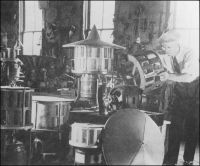Decot Machine Works
Decot Machine Works, later known as Decot Engineering Works, was a siren manufacturer based out of Sauk City, WI, in the first half of the 20th century. Founded by Theodore F. Decot (1878-1940), the company produced a variety of hand-built fire sirens over a span of 20 years, including the famous Red Arrow series.
History
Decot Machine Works
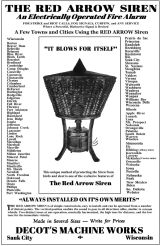
Decot Machine Works was founded by its namesake, Theodore F. Decot, in 1920. At the time, the fire siren market was booming, with fire stations all across the country looking for electric fire sirens to replace their old bells and airhorns. Companies such as Sterling Siren (then known as the Inter-State Machine Products Company), Federal Electric, and Erick Electric Siren Co. were seeing much success near to where Decot lived, and he decided to enter into the siren business. He inspected the aforementioned competitors' sirens, taking notes and studying them in order to design a siren of his very own. It was reported that various Type Mach. B units would be collected by Decot, studied, and never seen again afterwards. In 1921, Decot introduced the Red Arrow series of sirens, which quickly became known for their distinctive dual tone sound. Their simple design meant that they could be maintained with little effort, despite the unreliability of their Valley Electric motors. Despite their resemblance to Erick sirens, Decot's sirens have little in common.
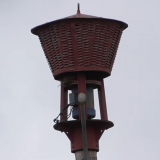
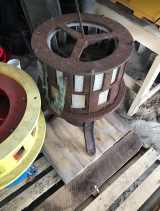
The very first units were built and sent to Sauk City and Reedsburg, WI in 1921. These early units were 15/20 port dual tone. Although each siren is hand-built and unique, they all used the same basic design, with the motor on the bottom where the mounting legs are attached. The mounting legs also serve as supports for the stator. Unlike most sirens, the Red Arrow series did not have the rotor shaft directly attached to the motor, but instead attached the rotor to the motor using a coupled driveshaft. The rotor and stator are enclosed inside of a large triangular housing with small holes to increase sound pressure, as well as protecting them from the elements. The housing is pointed on top. These sirens were also available without the housing, instead using only the pointed rainshield.
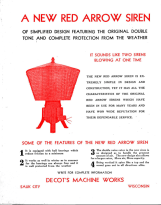
Decot tried many different prototypes as well, including an attempt to create a dual tone siren with a single tone rotor; this model utilized a cone shaped rotor and stator similar to an E.D. Bullard siren, in an attempt to force loud enough undertones to create a dual tone sound. This was not a success, however. Decot was always experimenting, looking for new ways to improve on his sirens. In 1935, Decot decided to try and improve on the design by directly coupling the motor to the rotor (which was made larger), removing the driveshaft, as well as no longer requiring the stator and housing to be attached to the mounting legs. This shortened the siren and made it easier to produce. These "New Red Arrows" are extremely rare, with one known surviving unit being privately owned. Theodore sourced many of his parts from other manufacturers, which meant that the quality of the sirens varied significantly, with casting defects not being uncommon and the motors performing somewhat unreliably. Theodore was not driven by motives such as profit, he simply enjoyed building sirens and seeing them be useful. In a way, Theodore can be considered one of the first "siren enthusiasts".
Decot Engineering Works
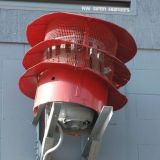
After Theodore Decot died in 1940 at the age of 62, his son Harold Decot attempted to keep the company running. Unfortunately, he was drafted into the U.S. Navy in 1941, preventing him from building sirens. As a result, the company was sold to John B. McGrath and Robert Fullerton, who were based out of St. Paul, MN. They reformed the company into Decot Engineering Works, which made their own sirens using largely the same core as the New Red Arrows. Most of these are 10/15 port, using a newer shroud that slightly resembles a Federal Model 5, or a Scream Master. This was meant to improve the overall performance of the sirens. Decot Engineering Works experimented further with different prototype siren designs, including a simple 6/10 port siren as well as a 15/20 port siren, which used a very short, wide rotor. These prototypes would be distributed to different towns, although they never saw mass production. DEW's sirens would be sold across the Midwest.
Unfortunately, McGrath and Fullerton could not keep the company solvent. DEW tried to mass-produce their sirens despite the lack of experience or ability to do so, and the new sirens quickly began to show quality control issues, with cracking rotors and failing motors becoming common problems. Their performance was also subpar compared to the Red Arrow sirens, and its competition in the siren market were outperforming and outselling them. With its reputation tarnished and sales dwindling, Decot Engineering Works would go under in 1944, shutting down permanently. Today, DEW sirens are few and far between, and are much rarer than the Red Arrows. Most surviving examples are inactive, though a handful are still in service.
Products
Outdoor warning sirens
Decot Machine Works
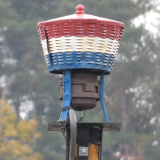
Red Arrow Model 15
The Model 15 is the smallest of the Red Arrow series, and is the only single tone model in the entire lineup. The Model 15 uses a 15-port single tone rotor and stator, coupled to a 1.5 hp AC motor. They are very comparable to Erick's high tone model. Their housings are much shorter due to the rotor also being much shorter, and lack the gap between the motor and the stator. They likely have the shortest range of Decot's sirens, and only a single unit remains in service today. Their decibel rating is unknown.
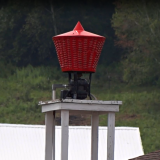
Red Arrow Model 30
The Model 30 is the weakest of the dual tone Red Arrow sirens. These use a much taller housing than the Model 15 to fit the dual tone rotor, and use a driveshaft to connect the motor to the rotor. The Model 30 uses a 3 hp AC motor, coupled to a 10/15 port dual tone rotor and stator. They were available with or without their conical shroud. Several of these units can still be found in service, and their decibel rating is unknown.
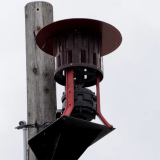
Red Arrow Model 50
The Model 50 is a more powerful version of the Model 30. Like the Model 30, it uses a 10/15 port dual tone rotor and stator, and is visually identical to a Model 30. However, the Model 50 uses a more powerful 5 hp AC motor instead. It is very difficult to differentiate a Model 30 from a Model 50 as a result. Two of these remain in service today, and their decibel rating is unknown. It is unknown in the increase in horsepower resulted in any increase in performance over the Model 30.
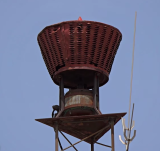
Red Arrow Model 12
The Model 12 is the largest and most powerful of the Red Arrow series, as well as the most popular. The Model 12 is physically much larger than the Model 30 and 50, and uses a 12 hp AC motor. The Model 12 is distinct from the Model 30 and 50 by its shorter, wider housing and different motor. The siren has two options, 10/15 and 10/16 port dual tone. Due to the additional stress the 10/16 port rotor puts on the motor, the Model 12 is the only model that supports it. The earliest units were 15/20 port. The Model 12 was by far the most popular model that Decot sold and is the most common Red Arrow found today.
Decot Engineering Works
D.E.W. 6/10 prototype
The first original creation by Decot Engineering Works after their takeover of the company following Ted Decot's passing, the 6/10 siren was a proof-of-concept for D.E.W.'s later designs. The siren was a dual tone electric siren consisting of a single 15 inch 6/10-port rotor and stator placed atop a Westinghouse 3 hp 3-phase 220V electric motor running at 3450 RPM. Unlike other sirens produced by either company, the 6/10 Decot uses a stator design heavily reminiscent of Federal Signal's Model 5T and SD-10 sirens, with heavily beveled ports. However, unlike either of the two aforementioned sirens, the 6/10 siren uses a dual-intake design with the 10-port side drawing in air from above and the 6-port side drawing in air from below. The siren sits on a large rounded base, where the housing bolts onto. This base has four holes allowing air to enter from below to feed the lower side of the rotor. The housing itself is very similar to housing designs used on D.E.W.'s other sirens, with two skirts surrounding a mesh-screened opening where the sound is mostly emitted, as well as a smaller rainshield on top that covers the upper intake and helping to project the intake sound.
Only one of these sirens is known to exist, the sole existing unit having been built in December of 1941. It originally served in Rock Springs, WI and is currently in private possession. It is unknown if more of these sirens were produced.
D.E.W. 15/20
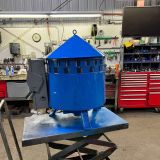
Another original design by D.E.W., this siren was D.E.W.'s take on Decot's original 15/20 Red Arrow sirens. Designed to use a lower-RPM motor with a high port count, this siren uses a short, wide 15/20-port rotor and stator placed atop a fat 5 hp 3-phase electric motor that runs at 1725 RPM. Like Decot's other sirens, the 15/20 siren uses a dual-intake design with the 20-port side drawing in air from above and the 15-port side drawing in air from below. The siren's core is protected by a cylindrical motor cover that bolts to the base of the siren, and a large rainshield on top protects the rotor and covers the upper intake. It is unknown how many of these sirens were produced and if it was a one-off design or not.
Only one of these sirens is known to exist, located in Forman, ND. This particular unit has seen multiple rebuilds during its life, particularly to the motor. The first restoration had the motor rebuilt into a 3450 RPM two-pole motor that caused the siren to operate at a much higher speed and pitch than it was originally designed to. This motor wore out in the early 2020s and the siren was taken down for a full restoration in 2023. This restoration gave it a fully rebuilt 4-pole motor and a disconnect attached to the side of the siren, as well as a distinctive blue paintjob that caused many enthusiasts to begin referring to it as the "Forman Blueberry". Unfortunately, this restoration was completely botched by whoever rebuilt it. Despite being claimed to match the original motor's specifications, this rebuilt motor had far too much starting torque that caused the siren to windup in less than a second. This proved to be too much for the rotor shaft/rotor itself to handle, causing it to fall out of alignment after many on/off cycles and begin scraping and knocking against the stator badly. The siren was taken out of service in October 2024 for good after it was decided that the rotor may have been damaged beyond operational condition. If left running in its current condition, the rotor could potentially crack or explode. As a result, this siren is likely going to be removed and placed in the town's museum.
